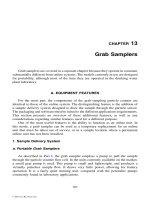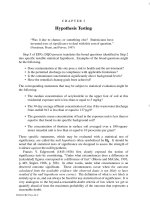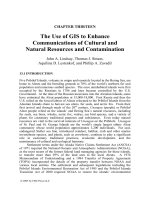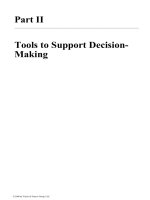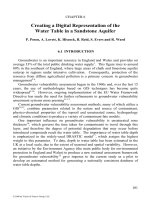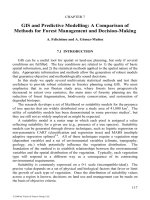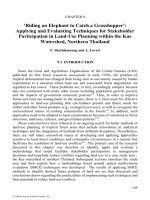GIS for Environmental Decision Making - Chapter 13 potx
Bạn đang xem bản rút gọn của tài liệu. Xem và tải ngay bản đầy đủ của tài liệu tại đây (913.63 KB, 16 trang )
211
CHAPTER 13
Multiple Windows on Accessibility: An Evaluation of
Campus Buildings by Mobility-Impaired and Able-
Bodied Participants Using PPGIS
C. Castle and C. Jarvis
13.1 INTRODUCTION
The 2001 Briefing of the Disability Rights Commission (DRC) estimated that
8.5 million people are disabled in the UK
1
, of whom over 1.8 million claimed
benefits for mobility difficulties
2
. The UK Government is committed to promoting
rights and improving opportunities for disabled people, and argues that disabled
people need to be brought into the mainstream of society in order to effect real
change in their lives, and to change stereotypical attitudes entrenched in society.
The implementation of the 1995 and 2005 Disability Discrimination Acts with their
measures to end inequity, and the setting up of the DRC, are examples of steps
being taken towards this objective
3
.
One area of change that these political moves have brought has been a
deliberate broadening of involvement within UK Universities, accompanied by
monies from bodies such as the Higher Education Foundation for England
(HEFCE) to implement urgent changes to campus environments
4
. Historically, an
exceptionally small percentage of those with disabilities would have survived the
educational process to reach higher education; participation rates remain low, but
are increasing
5
. Nevertheless, recent papers reporting views of disabled students
still point to continuing and frustrating problems in accessing their higher
education
5-7
. The physical accessibility of facilities to those with ambulatory
difficulties, the subject of this chapter, is one such area.
In their campus review, Shevlin et al.
8, p21
sum up their respondents’ comments
on the subject of access and mobility with the conclusion that ‘Students expend
enormous amounts of time and energy in negotiating many seemingly accessible
buildings’. This statement echoes themes common across several papers looking at
UK university life for the mobility-disabled
5-7
. Two important themes of particular
relevance to this chapter can be drawn from the assertion by Shevlin et al.
8
Firstly,
and taking a highly pragmatic view, how can better accessibility be achieved within
the immediate resource limits, whist continually increasing pressure for change;
and secondly, how can we bridge the information gap between portraying buildings
or routes as seemingly accessible, and reality?
© 2008 by Taylor & Francis Group, LLC
212 GIS for environmental decision-making
The answer to this first question is clearly ongoing, with a requirement for
structural and internal changes to UK campuses. In the meantime, can information
regarding the accessibility of buildings be better represented so less time and
energy is wasted unnecessarily? Detailed accessibility audits available via the
Internet can provide some measure of information for potential and indeed current
students at some Universities
7
. However, these are not a practical solution for the
student seeking to orientate themselves to a new campus or unfamiliar buildings on
a day-to-day basis, where a map might be more suitable. Earlier work by
Vujakovic and Matthews
9
, for example, demonstrates the potential of city-wide
accessibility maps, while one of Chard and Couch’s
7
respondents notes with
disappointment the removal of mobility-related symbolism on campus mapping.
Many campus maps do contain accessibility symbols, but there is little in the
cartographic literature regarding the most effective style, symbolism and scale of
approach to accessibility mapping. Moreover, the creation of accessibility maps
has traditionally required a significant surveying investment
9
, placing the ability for
construction and the power of content in the hands of delegated authority rather
than empowered citizen or group.
Secondly, and significantly, Shevlin et al.
8
use the term ‘seemingly accessible’
to describe campus buildings. There may be pragmatic issues connected with the
reliability of accessibility information produced by the able-bodied: planning rules
or detailed pro-forma used in accessibility audits may be implemented accurately,
yet their results miss important but individual facets of accessibility. In the context
of University life with its rich potential for social contact it seems that there is a
strong possibility that the UK’s ‘needs assessment’ approach to provision, and what
might be hoped for in an individual’s normal development, might part company
relatively easily. Neither do planning rubrics necessarily reflect the requirements
of individuals, in all their diversity; as Imrie
10, p464
notes, there is ‘more that divides
than unites disabled people’. These points are echoed by many poignant responses
across the wider socio-cultural literature. For example, one of Imrie and Kumar’s
11,
p367
respondents comments about a building which frustrates him (from an access
viewpoint), as it was identified as ‘fully accessible’ by the City Council in
Newcastle (a ‘fully accessible’ city), ‘… Now, you can imagine that other buildings
which don’t even match this quality are nowhere near accessible. But I think it’s
the perception of what’s accessible and what isn’t’. Certainly Vujakovic and
Matthews
9
identify significant differences in the mental maps of an area of
Coventry constructed by able-bodied and disabled participants of their study,
although they do not explore how different the maps of the two groups might be if
they were asked to construct a map for the assistance of those with ambulatory
difficulties. They do however find significant differences in choice of symbolism,
albeit from a very small sample. Taken together, these varied sources suggest that
accessibility information and maps may best be constructed by those who
themselves understand the constraints of the subsequent users.
© 2008 by Taylor & Francis Group, LLC
Evaluating campus accessibility using PPGIS 213
Many recent papers also highlight the moral imperative for partnership,
particularly in a research context
10,12
. Kitchin
12, p25
, following Oliver
13
, observes
that research should be ‘both emancipatory (seeking positive societal change) &
empowering (seeking positive individual change through participation)’.
Moreover, such partnerships are important if the products are to gain credibility;
another of Kitchin’s
12, p34
respondents suggests that ‘it is important that disabled
people undertake and present research because it makes more of an impact due to
the fact that it is `straight from the horse’s mouth`’. Whatever forms of
information are produced on accessibility, ‘it is only disabled people who can know
what it is like to be disabled and so only disabled people can truly interpret and
present data from other disabled people’
12, p26
.
Within this context, this chapter reports the findings of a pilot study exploring
the potential of a Public Participation Geographical Information System (PPGIS) to
build accessibility maps that draw on the local knowledge of campus respondents
with ambulatory difficulties for their detailed content. PPGIS have received much
attention within the GIS research community, particularly during the mid-to-late
1990s
14-18
. Critically in the context of respondent comments within the disability
literature, this particular study draws on other recent studies adopting a bottom-up
approach to PPGIS, where community members are able to proactively provide
information rather than be restricted to responding to information supplied to
them
19
. The approach taken here also follows that of Haklay and Harrison
20
and
Carver et al.
16
, who observe that PPGIS systems conducted via the Internet and
World Wide Web (WWW) can increase public participation in planning and, by so
doing, make such processes more democratic and locally relevant. Harris and
Weiner’s
17
work in particular stemmed from growing concerns about the
potentially disadvantageous social implications of GIS, and the need to use GIS to
empower disadvantaged and marginalized groups instead
21
. In the main, however,
previous work with PPGIS has been levelled at community responses to planning
applications, yet from recent respondents’ comments within the broader disability
literature PPGIS would seem an approach with high potential for accessibility
mapping.
In particular, this chapter reviews the development and results of a PPGIS for
accessibility mapping developed for the central campus at the University of
Leicester in the summer of 2003. We investigate the ease by which the PPGIS
framework was used and developed by campus participants, the perceived
usefulness of the products and the potential level of empowerment that might be
achieved by the approach. As an important component of the study, we also asked
a sample of able-bodied students to build accessibility maps within the same
setting, based on their perceptions of requirements.
© 2008 by Taylor & Francis Group, LLC
214 GIS for environmental decision-making
13.2 METHODOLOGY
13.2.1 PPGIS: Technical Framework
The primary software package used for this study was Questionmark
™
’s
Perception
™22
. While alternative software such as ESRI’s ArcIMS
®
and
Microsoft’s MapPoint
®
Web Service could potentially offer greater flexibility and
resources for participants developing their own accessibility maps, we were keen to
avoid major obstacles in using the system for those not familiar with GIS. The
Perception package offers an extensive range of question delivery options,
particularly drag and drop questions, which were used to place symbols over a
familiar cartographic base of the existing campus map. Thus, the software offered
both the ability to create the accessibility maps in a manner that was expected to be
relatively easy for the non-expert user, while simultaneously delivering the
remainder of the questions for each of the cartographic trials.
The Perception mapping interface was embedded within an Internet site, which
served a variety of functions. Primarily designed to collect and display the
empirical data, it also served to advertise and explain the purpose of the research.
Additionally, the Web site provided a schedule of the project to keep participants
informed of when surveys became available online. Amongst other pages, a results
archive provided the participants with the survey results and links to further
reference material. This approach enabled the PPGIS to work essentially as a self-
generating survey, with the potential for a cumulative rate of growth.
13.2.2 PPGIS: Stages of Development
The cartographic development of the PPGIS was divided into two trial stages,
the symbolism trials and the mapping trials.
The symbolism trials were designed principally to investigate which
accessibility symbols should be included in the final maps. Mindful of the
cartographic findings of Fry
23
and Vujakovic and Matthews
9
, and also the need to
engage with participants at the early planning stages of the work, a secondary aim
of this trial was to examine preferences regarding the symbols themselves. A
questionnaire was used for this process, rather than the preferred focus group
approach, owing both to data protection issues and also the timing of the study in
regard to students’ examinations and summer leave. Only participants with
mobility difficulties were requested to complete the symbolism trial.
The mapping trials allowed both participants with mobility difficulties and
able-bodied participants to construct an individual accessibility map of the campus.
These individual products were subsequently developed into community maps. On
the Internet site (available at
respondents could add predefined symbols describing accessibility levels to a
familiar map of the central Leicester University campus (see screenshot in Figure
13.1). The chosen symbols from the previous symbolism trial (decided by the
© 2008 by Taylor & Francis Group, LLC
Evaluating campus accessibility using PPGIS 215
majority of votes received), could be ‘dragged and dropped’ onto a detailed map of
the buildings within Leicester campus. Participants were required to 'click' on any,
and as many of, the tiles which comprised the site map, for locations where they
had knowledge of access to, and facilities within buildings for people with mobility
difficulties. The maps were split into tiles to decrease the download time, and to
make adding symbols more manageable. Questions (1-15) represented a different
symbol within the cartographic trial, i.e., Q1 level access, Q2 steps, etc., but the
actual symbols available for ‘drag and dropping’ were solid blue boxes (just visible
in the bottom-left corner of Figure 13.1), representing the symbol stated at the
beginning of each question. For Question 16 participants had to select
accessibility classification from a pull down list which matched (as close as
possible) the overall accessibility characteristics of each building the participant
assessed within this tile.
Figure 13.1 Example of the screen layout for the symbol mapping trial.
The final classification maps (see example in Figure 13.2) were created by
analyzing the results of Question 16, while the individual building accessibility
symbol maps were produced from Questions 1-15, as shown in Figure 13.3.
© 2008 by Taylor & Francis Group, LLC
216 GIS for environmental decision-making
Placement of the individual symbols was determined by producing simple density
and contour maps for each symbol type.
Figure 13.2 Partial view of accessibility classification maps and key produced by participants with
mobility difficulties (left), and able-bodied participants (right). Numerals within each building represent
the number of participants who contributed to the classification of accessibility.
Figure 13.3 Comparison of accessibility symbol maps produced by participants with mobility
difficulties (left and top), able-bodied participants (right and bottom) for the George Porter and Fraser
Noble buildings. Classification of building accessibility uses the same shading as in Figure 13.2.
© 2008 by Taylor & Francis Group, LLC
Evaluating campus accessibility using PPGIS 217
Respondents for both trials were recruited in several ways. An email was
posted to persons known to Leicester University’s AccessAbility Centre (AAC),
and leaflets and posters were distributed around the campus. While the Web site
was available to all, the principal targets of the initial surveys were disabled people,
carers, and their families/friends. The study was open to those with disabilities of
both a permanent and temporary nature, and the classification of disability was
open to the respondents’ interpretation. We recognize that our focus on ambulant
disability covers only a proportion of disabled people, and especially neglects
people with visual impairments. However, the visual nature of this work prevented
people with a serious visual impairment from participating in this research.
13.2.3 PPGIS Evaluation
Participants’ perceptions and attitude towards PPGIS, and their practical
experience producing and using the accessibility maps, were reviewed by
questionnaire, for reasons previously stated. Freeform space was however
incorporated within this format, with a prompt for participants to comment
regarding any matters not explored by the set questions or the relevance, use or
expression of the questions. Similar to the symbolism trial, only participants with
mobility difficulties completed this evaluation. Before participants started the
evaluation form, a brief outline of PPGIS was provided.
Five issues were investigated within the evaluation, a list that reflects the
context of the Leicester study (as a pilot for a wider town study), with an academic
and computer literate populace:
• The ease and efficiency of producing the accessibility maps using the GIS
system, in contrast to respondents’ perceived ease of cartographic trials by
hand on paper;
• Participants’ general confidence in producing accessibility maps that
accurately mirrored their intentions;
• Respondents’ overall experience with PPGIS during the study, and
suggestions for improvement;
• The value participants placed on the resultant accessibility maps;
• Respondents’ perceptions of PPGIS as a means of empowering
disadvantaged and marginalized groups in campaigns for public access
and planning regulations.
13.3 RESULTS
Sixteen participants (11 of whom were female) with ambulatory mobility
difficulties contributed to the study, representing 40% of the eligible population
with a registered mobility difficulty across the university. The majority of these
participants (13) were students under the age of 45, and all held a job or attended
© 2008 by Taylor & Francis Group, LLC
218 GIS for environmental decision-making
lectures that required them to use multiple locations on the campus, on a daily
basis. Similar to the participants with mobility difficulties, the age profile of the 16
able-bodied participants was positively skewed, with the majority (14) of
participants under the age of 35, nine of whom were female.
13.3.1 Symbolism Trial (Only Participants with Mobility Difficulties)
The first nine symbols (level access, steps, parking, cash machine, restaurant
access, access via ramp, accessible computer terminal, lift access and telephone
access) were accepted by the majority of respondents with mobility difficulties
(more than 13 in every case) as appropriate for inclusion within the accessibility
maps. Only a few respondents suggested that clearer and/or more appropriate
symbols were available, but they were unable to indicate viable alternatives.
However, one symbol that participants did not think would best represent the
accessibility of a location (10 respondents), and should not be included in the
accessibility symbol maps (11 respondents), was the minimum doorway width
symbol. From the choice of a unisex symbol for toilet facilities, one for each sex,
or all three of these depending on the facilities available, 10 respondents elected for
all three possibilities to remain available to them. Within the open question area,
additional symbols for difficult/double/heavy sets of doors (six respondents) and
electronic doors (10 respondents) were requested and subsequently added to the
final range.
In response to the penultimate question, asking whether participants would like
to indicate areas that were particularly inaccessible using symbols struck through
with a red cross, 14 participants said no.
The final question examined a possible solution if participants said that
a/multiple symbol(s) offended them, or over emphasized their disability. A
selection of ‘abstract’ and ‘conceptual’ symbols designed by Fry
23
were presented
as alternatives to the pictorial versions. Respondents unanimously voted to use the
pictorial symbols and 13 felt that these did not emphasize a/their disability.
13.3.2 Mapping Trial (All Participants)
The mapping trials generated general accessibility classification maps by
participants with mobility difficulties and those who were able-bodied (see Figure
13.2, left and right respectively). Information regarding the accessibility of
buildings on the campus was submitted for 28 map tiles by participants with
mobility difficulties and for 47 by able-bodied participants. In total, over 95% of
the spatial data created by the participants was used to create the final accessibility
symbol maps (Figure 13.3). All of the accessibility symbol maps for individual
buildings and the general accessibility classification maps can be viewed at
Analysis of the building access classifications revealed several clear differences
between the maps produced by the two groups of participants. Table 13.1 lists the
© 2008 by Taylor & Francis Group, LLC
Evaluating campus accessibility using PPGIS 219
results for individual buildings. Able-bodied students perceived 17 buildings
(53%) to have full/partial access to the majority of floors, but with limited facilities
available within these buildings (Category 3 in Figure 13.2). Another 12 buildings
(38%) were considered fully accessible with many facilities available (Category 4).
Table 13.1 Classifications of building accessibility by study participants
Access Category by
Participant Group
Building Name
Mobility
Difficulties
Able-Bodied
Difference in
Able-Bodied
Participants’
Perception
Fraser Noble 2 3 More Accessible
School of Education 1 1 3 More Accessible
School of Education 2 2 3 More Accessible
School of Education 3 2 3 More Accessible
School of Education 4 2 3 More Accessible
School of Social Work 1
a
N/A 3 N/A
School of Social Work 2
a
N/A 3 N/A
Museum Studies 1
a
N/A 3 N/A
Museum Studies 2
a
N/A 3 N/A
Institute of Life Long Learning N/A 1 N/A
Regent Road House 1
a
1 N/A N/A
Regent Road House 2
a
1 N/A N/A
Regent Road House 3
a
1 N/A N/A
Bennett 4 4 Same
Bennett Link 4 4 Same
Adrian 3 4 More Accessible
Maurice Shock 3 N/A N/A
Physics and Astronomy 4 4 Same
Rattray 4 4 Same
George Porter 2 4 More Accessible
Charles Wilson 3 4 More Accessible
Chemistry Research 1 N/A N/A
Computer Centre 1 1 Same
Attenborough Tower 4 4 Same
Attenborough Seminar Block 2 3 More Accessible
Percy Gee 3 3 Same
College House 2 3 More Accessible
Maths and Computer Science N/A 4 N/A
Ken Edwards 4 4 Same
Engineering 1
b
N/A 3 N/A
Engineering 2
b
N/A 3 N/A
Engineering 3
b
N/A 3 N/A
Library 4 4 Same
Law 3 3 Same
Fielding Johnson 3 3 Same
Astley Clarke 3 4 More Accessible
Security Lodge N/A 2 N/A
Note: N/A = Not assessed.
a
Ordered from top on map.
b
Ordered clockwise from top right.
© 2008 by Taylor & Francis Group, LLC
220 GIS for environmental decision-making
Participants with mobility difficulties perceived the accessibility and facilities
of the buildings rather differently. Six buildings (21%) were considered to have no
access or facilities available for people with mobility difficulties (Category 1). A
further eight buildings (29%) were considered to have access only to their ground
floors (Category 2). Of these buildings, six were classed as Category 3 by the able-
bodied participants, and one was rated as Category 4. Seven buildings (25%) were
classed as Category 3 by participants with mobility difficulties, but of the six also
assessed by the able-bodied students only three were given the same classification
and the other three were graded as Category 4. Finally, another seven buildings
(25%) were rated as Category 4 by the participants with mobility difficulties, all of
which were assessed and given the same classification by the able-bodied
participants.
Overall, 22 of the 37 campus buildings were classified by both groups of
participants. In half of these cases (i.e., 11) the ratings from the two groups were
the same and in the other half the buildings were perceived as more accessible by
able-bodied respondents than those with mobility difficulties. None of the
buildings were regarded as less accessible by the able-bodied participants.
Not only did able-bodied participants perceive campus buildings to be generally
more accessible, but for the buildings that both groups assessed, able-bodied
participants only contributed 77% of the accessibility symbols provided by those
with mobility difficulties (excluding parking symbols). In fact, although able-
bodied participants assessed 14% more buildings, they contributed 21% fewer
symbols. Figure 13.3 illustrates these two trends. Able-bodied participants
classified the George Porter building as being fully accessible with many facilities
available for people with mobility difficulties. However, they were unable to
provide any indication of these facilities. On the other hand, participants with
mobility difficulties assessed the George Porter building as only having ground
floor access, with limited facilities. Similarly, the Fraser Noble building (an
examination hall) was rated by able-bodied participants as fully/partially accessible
with limited facilities while respondents with mobility difficulties classified it as
ground floor access only, with limited facilities. Several participants with mobility
difficulties confirmed that their classification was a result of the building
containing multiple steps and staircases to other floors, with no lift access. Other
examples of such differences were also recorded and can be found at
/>htm (not navigable from the main Internet site).
Copies of the final accessibility maps, and information regarding the project
Web site, were sent to Leicester University’s AccessAbility Centre.
13.3.3 PPGIS Evaluation (Only Participants with Mobility Difficulties)
The majority of respondents perceived the PPGIS system an efficient means of
submitting and representing their local knowledge. They were comfortable with
© 2008 by Taylor & Francis Group, LLC
Evaluating campus accessibility using PPGIS 221
the computer environment, and were pleased that the system allowed them to
control their time on screen. For example, one participant commented that ‘the
ability to add information regarding individual facilities for small areas allowed,
and ensured, that I kept on coming back to add information when it was convenient
to me’. Respondents were also largely confident of their ability to make
submissions to the mapping system that were being captured correctly, although a
number of small technical matters were highlighted for adjustment in future work.
With respect to the advantages of the PPGIS approach, most participants agreed
a priori that accessibility maps were a useful idea, and which would have been
desirable when they first arrived at the university. In particular, one respondent
noted that ‘the University has produced a rudimentary accessibility map, but it only
has some detail, it doesn’t indicate all of the facilities available in buildings like
these maps’. Of the 16 participants, six had actively used the final accessibly maps
by the time they had completed the evaluation questionnaire. Eighty five percent
found the level of information contained within the maps to be excellent, while the
remainder found it sufficient. The general classification maps scored highly on
reliability across the cohort, while those regarding symbolism were rated slightly
lower. Nevertheless, the latter were still marked as between excellent and
sufficient by all but one respondent. Fifteen of the 16 respondents found the
Internet availability of the final maps to be advantageous.
Importantly in regard to the objective of empowerment, 13 study participants
thought that the accessibility maps would give them considerably more confidence,
two slightly more confidence, and one about the same amount of confidence when
navigating around the campus. The level of confidence fell when respondents used
the map to access unfamiliar buildings for the first time, with four and twelve
participants stating that they had been given considerably more, and slightly more
confidence (respectively) in their ability to move about the campus. More
generally, after this project 15 of the 16 respondents perceived the use of PPGIS as
a means of producing future accessibility projects as valuable, and endorsed their
questionnaires with comments that included ‘hopefully a national scheme will be
developed, this would make visiting new places so much easier’, and ‘very
promising for disabled people’. The final conclusion of the respondents was
almost unanimous that PPGIS had the potential to empower disadvantaged and
marginalized groups, although the viability of the concept in practice was in
slightly more doubt.
13.4 DISCUSSION
Although a number of technical adjustments were required to improve the
PPGIS interface, the respondents were confident with its use and in submitting their
contributions. This was expected of the university cohort involved, since computer
literacy is a central tenet of Leicester’s teaching and learning strategy, but could not
© 2008 by Taylor & Francis Group, LLC
222 GIS for environmental decision-making
necessarily be anticipated in a wider city center context. These issues will be
explored further in a future Enfield Town study. In cartographic terms, the outright
rejection of Fry’s
23
symbolism for accessibility supports the findings of Vujakovic
and Matthews’
9
smaller study. The campus area for this investigation has broad
paths with smooth pavements, dropped curbs, and only a few very steep slopes, so
allowing a focus on building characteristics. This contrasts considerably with
Vujakovic & Matthews’
9
city study, in which the participants placed more
emphasis on the external environment (cobbles, curbs, etc). The Leicester
respondents also demonstrated an interest in further pan and zoom facilities, raising
interesting issues of scale and generalization that will require consideration in the
follow-on Enfield study, where the population is more diverse and better
representative of the UK as a whole. Further research is also required to establish
the best means of presenting PPGIS to those with visual impairment, an important
sub-group of those with mobility difficulties that is not addressed in this study.
From a practical perspective, the PPGIS approach to accessibility mapping
allowed a body of local knowledge to be built up relatively rapidly, at low cost, in
the participants’ own time frame and independent of authority. However, the
relatively limited geographical context of this study, together with the low numbers
of those with disability represented at the University, suggests that the further
growth potential of this particular PPGIS is relatively limited within a short time
scale. Respondents enjoyed being able to continually assess accessibility
throughout the study; incorporating information about new facilities they might
encounter, or modifications to the campus. Some further thought is required on the
incorporation of rolling improvements to facilities with respect to building
classifications, where the mapped information becomes out of date until it receives
high numbers of corrective inputs. Libraries, canteens and bars are also a critical
part of intellectual and social life at university and Borland and James
5
, together
with discussions in Leicester, highlight the important possibility of extending the
coverage of mapping to frequented off-campus settings such as local pubs and
cafes.
While in many senses this PPGIS is, from a technical viewpoint, an example of
what has been termed a community mapping system, we have nevertheless retained
the PPGIS terminology for an important reason; the need for participation and
partnership is a strong theme in recent disability research. The PPGIS
nomenclature echoes this parallel research more strongly. Moreover the
characteristics of the accessibility map sets produced by the two groups of
contributors are significantly different. This provides methodological triangulation
to the body of individual comments on representations of disability, adding further
weight to the need for partnership to achieve credible research and practical
outcomes. There has been little recent work on accessibility mapping and one of
the respondents in this study hinted at their perception of standard mappings as
incomplete or unrepresentative and therefore unusable. This is despite a genuine
© 2008 by Taylor & Francis Group, LLC
Evaluating campus accessibility using PPGIS 223
attempt to construct a useful cartographic product in the case of the Leicester
campus, a situation potentially echoed elsewhere. To cover ground in the detail
achieved in this study, if organized in a standard fashion, would require resource
intensive survey campaigns
7,9
; the PPGIS framework therefore offers an efficient
means of achieving the required detail and reliability.
Questions regarding the extent to which the PPGIS increased confidence in
mobility for existing students suggest individual empowerment at some level, the
nature of which could usefully be examined further through unstructured
interviews. This is important; the study aimed to address the concept of individual
experience at University, not average experiences or community campaigning in
isolation. We acknowledge that respondents evaluating the PPGIS in favorable
terms were also those who supplied the information it contained, yet the
construction of information by the community for the community and the
amalgamation of individual experience by building and across campus are notions
central to the study. Forty percent of the registered potential cohort at Leicester
engaged with this research, suggesting an overall benefit to those for whom the
research was directly applicable. Respondent comments from previous studies
12
indicate that this is an outcome relatively rare in disability research, although much
desired.
With regard to the low representation of those with disabilities at University, we
might also wonder whether the growth of reliable accessibility maps constructed by
those with credence have the potential to encourage wider access. One of
Kitchin’s
12, p34
respondents suggests for example that ‘it’s quite easy for you to see
that I can’t get on the bus, I can’t get into 60% of the shops, I can’t get into most of
the universities’. It is clear from this study that many physical barriers remain
across the Leicester campus, as others
5,7
. However, if a PPGIS approach can add
confidence to those already partly familiar with an environment, then there is also
the possibility that the detailed information provided may also give assurance to
those considering what is largely unknown territory. While disability is an
inherently individual experience
10
it would be interesting to explore whether the
participatory nature of the PPGIS serves to build a sense of connection.
This chapter takes a largely pragmatic and passive approach from a political
stance, looking at mitigating ambulatory disability on campus through
disseminating information generated from the collective local knowledge of the
community. In this sense, the PPGIS research direction presented has yet to
become emancipatory. However, the collective information provides a strong
evidence base when considering campaigns for change across the campus.
Handley
24
points out that a rights-, rather than needs-based approach to disability
provision may be overly idealistic owing to the sheer individuality of need within
contexts of limited resources. This PPGIS offers individuals an independent means
of defining physical barriers affecting their mobility and access requirements in the
built environment, which may be presented as the collective priority for change.
© 2008 by Taylor & Francis Group, LLC
224 GIS for environmental decision-making
The anonymous face of PPGIS will not however lever change on its own; it will
need champions to shape the concept, spread the word on its value and to make
political mileage with the broader community. Further research will also be needed
in regard to ensuring that the views represented are those of genuine respondents
without excessive ‘people monitoring’.
13.5 CONCLUSIONS
Several interesting and distinct conclusions can be drawn from the results
presented in this study. In particular, the research demonstrates that Internet and
questionnaire strategies can be successfully and effectively adapted to evaluate,
revise and contribute to disability access mapping within a designated area.
Moreover, clear differences were apparent between the accessibility maps produced
by participants with mobility differences and those who were able-bodied. In
general, the able-bodied participants perceived the buildings within Leicester
University campus to be more accessible, and to have more facilities available than
those with mobility difficulties. Half of the buildings assessed by both parties were
evaluated as more accessible by able-bodied students and none of them were rated
as less accessible. In addition, able-bodied participants were only able to contribute
77% of the accessibility symbols that participants with mobility difficulties
provided. These findings confirm the need for partnership when developing
accessibility maps. Importantly, the results also identify significant improvements
in the confidence of individual users who have access to what they consider to be
detailed, relevant and reliable products. These initial results suggest that
accessibility mapping using PPGIS has the potential for empowerment.
Although there have been, and continue to be, improvements in access to
facilities for those with ambulant disabilities on campus, further enhancements are
still required. In addition to questions of resource, the results of this study suggest
that the perceptions of able-bodied people concerning access requirements may be
why some services retain inaccessible features. While responses to individual
‘rights’ are resource intensive, PPGIS offers a means by which individuals may
state their own requirements for access in a manner that builds a collective priority
for action and provides weight to requests for change. In this emancipatory
context, however, careful consideration must be applied, and further research
undertaken, to prevent any constituent of a participating population being
ostracized while ensuring the credibility of the knowledge sources.
13.6 REFERENCES
1.
Disability Rights Commission (DRC), Disability briefing: February 2001, -
gb.org/disabilitybriefing/feb01/Page356.asp, Accessed on October 8th, 2003.
© 2008 by Taylor & Francis Group, LLC
Evaluating campus accessibility using PPGIS 225
2.
Department for Work and Pensions (DWP), Disability living allowance quarterly statistics,
2006.
3.
Department for Work and Pensions (DWP), Information for disabled people and carers,
2006.
4.
Higher Education Funding Council for England (HEFCE), Access to Higher Education: Students with
Special Needs, HEFCE, Bristol, 1995.
5.
Borland, J. and James, S., The learning experience of students with disabilities in Higher Education: a
case study of a UK university, Disability & Society, 14, 85-101, 1999.
6.
Parker, V., Personal assistance for students with disabilities in HE: the experience of the University of
London, Disability & Society, 14, 483-504, 1999.
7.
Chard, G. and Couch, R., Access to higher education for the disabled student: a building survey at the
University of Liverpool, Disability & Society, 13, 603-623, 1998.
8.
Shevlin, M., Kenny, M., and McNeela, E., Participation in higher education for students with
disabilities: an Irish perspective, Disability & Society, 19, 15-30, 2004.
9.
Vujakovic, P. and Matthews, M., Contorted, folded, torn: environmental values, cartographic
representations, and the politics of disability, Disability & Society, 9, 359-374, 1994.
10.
Imrie, R., The role of access groups in facilitating accessible environments for disabled people,
Disability & Society, 14, 463-482, 1999.
11.
Imrie, R. and Kumar, M., Focusing on disability and access in the built environment, Disability &
Society, 13, 357-374, 1998.
12.
Kitchin, R., The researched opinions on research: disabled people and disability research, Disability
& Society, 15, 25-47, 2000.
13.
Oliver, M., Changing the social relations of research production, Disability, Handicap and Society, 7,
101-114, 1992.
14.
Armstrong, M.P., Densham, P.J., and Kemp, K.K., Collaborative spatial decision making: scientific
report for the specialist meeting, National Center for Geographic Information and Analysis, Santa
Barbara, 1995.
15.
Ball, J., Towards a methodology for mapping 'regions for sustainability' using PPGIS, Progress in
Planning, 58, 81-140, 2002.
16.
Carver, S., Evans, A., Kingston, R., and Turton, I., Web-based public participation geographical
information systems: an aid to local environmental decision-making, Computers, Environment and
Urban Systems, 24, 109-125, 2000.
17.
Harris, T. and Weiner, D., GIS and Society: Scientific Report of the 1-19 Meeting, NCGIA Technical
Report 96-7, National Center for Geographic Information and Analysis, Santa Barbara, 1996.
18.
Craig, W.J., Harris, T.M., and Weiner, D., Empowerment, marginalisation, and public participation
GIS: report of the Varenius workshop,
1999.
19.
Craig, W.J., Harris, T.M., and Weiner, D., Community participation and geographic information
systems, in Community Participation and Geographic Information Systems, Craig, W. J., Harris, T. M.,
and Weiner, D., Eds., Taylor and Francis, London, 2002, 3-16.
© 2008 by Taylor & Francis Group, LLC
226 GIS for environmental decision-making
20.
Haklay, M.E. and Harrison, C.M., The potential for public participation GIS in U.K. environmental
planning: appraisals by active publics, International Journal of Environmental Planning and
Management, 45, 841-863, 2002.
21.
Pickles, J., Ed., Ground Truth: The Social Implications of Geographic Information Systems, Guilford
Press, New York, 1995.
22.
Questionmark, Perception software, 2006
23.
Fry, C., Maps for the physically disabled, The Cartographic Journal, 25, 20-28, 1988.
24.
Handley, P., Trouble in paradise - a disabled person's right to the satisfaction of a self-defined need:
some conceptual and practical problems, Disability & Society, 16, 313-325, 2000.
© 2008 by Taylor & Francis Group, LLC
